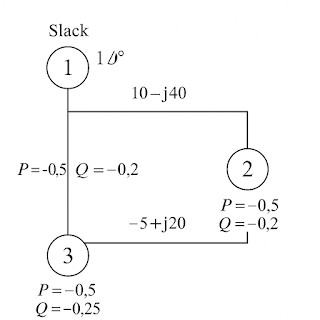-
Designing future expansion
-
Optimizing existing networks
-
Real-time monitoring
-
Planning contingencies
The load flow problem is inherently non-linear, and its solution requires iterative numerical methods. Among the most commonly used techniques are:
-
Gauss-Seidel Method
-
Newton-Raphson Method
This article will cover both these methods in detail, explain their differences, and discuss where and when to use them.
1. Power Flow Problem Formulation
For a power system with n buses, we categorize buses as:
-
Slack Bus: Voltage magnitude and angle are specified (reference bus).
-
PV Bus: Real power and voltage magnitude are specified.
-
PQ Bus: Real and reactive powers are specified.
The power flow equations for bus i are:
Where:
-
: Voltages at buses i and j
-
: Element of the admittance matrix
-
: Voltage angles
-
: Angle of admittance
These equations are non-linear and are solved using iterative techniques.
2. Gauss-Seidel Method
Overview
The Gauss-Seidel method is an extension of the classical technique used for solving linear equations. It updates bus voltages sequentially and uses the latest values during the iteration.
Steps
-
Initialize voltages for all buses (usually 1∠0° p.u.).
-
Update each PQ bus voltage using:
-
Continue iterations until convergence is achieved (voltage change below tolerance).
Advantages
-
Simple to understand and implement.
-
Low memory requirement.
Disadvantages
-
Slow convergence, especially for large systems.
-
Sensitive to initial guess and ordering.
3. Newton-Raphson Method
Overview
The Newton-Raphson method uses a Taylor series expansion and Jacobian matrix to solve the power flow equations. It’s more mathematically intensive but offers faster and more reliable convergence.
Steps
-
Formulate a set of non-linear equations:
Where is the state vector.
-
Perform Taylor series expansion:
-
Solve linear system for Δx and update state variables.
-
Iterate until is less than specified tolerance.
Jacobian Matrix Structure
Advantages
-
Fast convergence, typically within 3–6 iterations.
-
Less sensitive to system size and initial guesses.
Disadvantages
-
Requires more memory and computational power.
-
More complex to program.
4. Comparison: Gauss-Seidel vs Newton-Raphson
| Feature | Gauss-Seidel | Newton-Raphson |
|---|---|---|
| Convergence Speed | Slow | Fast |
| Complexity | Low | High |
| Memory Requirement | Low | High |
| Sensitivity | High (initial guess, size) | Low |
| Preferred For | Small systems | Large and complex systems |
5. Numerical Example (Simplified)
Assume a 3-bus system:
-
Bus 1: Slack (1∠0°)
-
Bus 2: PQ (P = -0.5, Q = -0.2)
-
Bus 3: PQ (P = -0.6, Q = -0.25)
Y-Bus matrix:
Using either method, we solve for voltage magnitude and angles at Bus 2 and 3. Newton-Raphson would converge in ~3–4 iterations, while Gauss-Seidel may require 15+.
(For actual computation steps, a simulation or detailed walkthrough with complex arithmetic is ideal.)
FAQs
Q1: Why is load flow analysis important?
A: It helps engineers plan, operate, and expand the power system reliably by determining power flows, voltages, and losses.
Q2: Which method should I use for a large power system?
A: The Newton-Raphson method is preferred for large and complex systems due to its fast convergence and robustness.
Q3: Can Gauss-Seidel method be used in real-time applications?
A: Not ideally. It is slow and less stable compared to Newton-Raphson, making it unsuitable for real-time operations.
Q4: What are typical convergence criteria?
A: A common criterion is when the change in bus voltage magnitude or angle is less than per unit or radians.
Q5: Are there other methods besides these two?
A: Yes, alternatives include:
-
Fast Decoupled Load Flow (FDLF)
-
Modified Newton-Raphson
-
DC Load Flow (approximate method)
Conclusion
Load flow analysis is a cornerstone of power system engineering. Both Gauss-Seidel and Newton-Raphson methods have their place in power system studies. While Gauss-Seidel is educational and easy to code, Newton-Raphson stands out in real-world power systems due to its efficiency and reliability.
For practical applications, especially in modern high-voltage networks, Newton-Raphson is the method of choice.


